Opatów
Opatów ([ɔˈpatuf] (![]()
Opatów | |
|---|---|
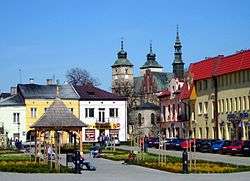 Main Square in Opatów | |
 Coat of arms | |
 Opatów | |
| Coordinates: 50°48′18″N 21°25′29″E | |
| Country | |
| Voivodeship | Świętokrzyskie |
| County | Opatów County |
| Gmina | Gmina Opatów |
| Area | |
| • Total | 9.36 km2 (3.61 sq mi) |
| Population (2012) | |
| • Total | 6,658 |
| • Density | 710/km2 (1,800/sq mi) |
| Postal code | 27-500 |
| Area code(s) | +48 15 |
| Car plates | TOP |
| Website | http://www.umopatow.pl/ |
Tourist attractions include a 12th-century Collegiate Church of St. Martin, 15th-century baroque Bernardine monastery, 16th-century city gate, and several other notable buildings.
History
In the Middle Ages, Opatów was a settlement on the Opatówka River, in an area of forests and lakes. First mentioned in 1189, it was the residence of the regional ruler (Castellan) and one of the largest settlements of the Sandomierz Land. First church was built here sometime in the 11th century. In the 12th century, St. Martin collegiate church was built as well. The purpose of the collegiate church is not known, it was probably designed for a Roman Catholic diocese which was created in Sandomierz instead.
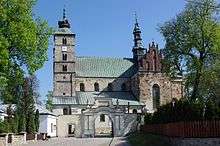
In 1232, prince Henryk Brodaty transferred Opatów to Lawrence, Bishop of Lubusz. In 1237, it was granted privileges that regularized the status of its residents and in 1361 it received the status of a city with wide privileges. In the first half of the 14th century, Bishop of Lubusz Stefan II decided to move the center of the town to the hill near the collegiate church. New town was called Great Opatów (Opatów Wielki), also Magnum Oppathow and Magna Opatow.

For centuries, until the Partitions of Poland, Opatów was an important regional center of Lesser Poland. During an invasion of the Tartars (1502), the town was destroyed. In 1514, it was transferred to Krzysztof Szydłowiecki, who restored it, surrounded with a defensive wall, built a castle and offices for the local government, and improved the water supply to the residents. Opatów had two annual fairs and two market days a week. In the 16th century, Opatów had a population of roughly 4,000 and was the biggest town of the province, even bigger than Sandomierz. The town was a center of political life of the Voivodeship; here General Sejmiks of the Lesser Poland Szlachta nobility took place. In 1551 Opatów burned almost completely. The great fire marked a slow decline of the town. In 1655, Opatów was destroyed in the Swedish invasion of Poland. The town also suffered during other conflicts including the Great Northern War, the Bar Confederation, the Polish–Russian War of 1792, and the Kościuszko Uprising. It belonged to a number of noble families (Tarnowski family, Ostrogski family, Lubomirski family, Potocki family, and Karski family), and remained in private hands until 1864.
In the 18th century, Opatów became home to a number of Greeks, who had escaped to Poland from the Turkish occupation of their homeland (see Ottoman Greece). They were allowed to open Orthodox churches. In 1778, an Orthodox parish of St Nicholas was opened, which in 1837 was moved to Radom. During the January Uprising, two battles took place in Opatów between Russians and II Corps of General Józef Hauke-Bosak. Poles captured the town on November 25, 1863, and withdrew with seized Russian guns and ammunition. On February 21, 1864, the second battle took place. It was one of the largest skirmishes of the uprising, and it ended in Polish defeat.
Jewish community of Opatów
Opatów was the first town in the Sandomierz Voivodeship, in which Jews settled.[1] The original Jewish privileges were issued in 1545 by the Grand Crown Hetman Jan Tarnowski, the starost of Sandomierz and the owner of Opatów.[1] Local Jewish community was first mentioned in the books of the Roman Catholic ecclesiastical Chapter in 1612.[1]
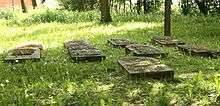
Prior to World War II, Opatów had a substantial Jewish population. Known as 'Apt' in Yiddish, Opatów became home to 6,000 Jews with a history of rich cultural and religious life. Best known from among the locals was the 18th century Rabbi Avraham Yehoshua Heshel (Apter Rebbe), who was instrumental in the development of the Chasidic movement, and the famous Noda Be'Yehuda of Prague, one of the leading halakhic authorities of 18th Century Europe. Jewish life in Apt has been chronicled by Professor Gershon Hundert in his 1992 book The Jews in a Private Polish Town, drawing upon a variety of sources from the history of Jews in Poland.[2] The work describes the demographic and historical background as well as the structure of the Jewish community of Apt (Opatów) with a population numbering about 2,000 in 1765, exceptionally large for any Jewish shtetl in the 18th century Europe. The town's Jewish inhabitants enjoyed considerable prominence also in the following centuries. Hundert uses the Jewish Opatów as a case study for Polish Jewry. More than three-quarters of them lived on private lands of powerful magnate aristocrats known as the Szlachta. Hundert's work also describes the vibrant interaction of the Jews of Apt with their Polish Christian neighbours. It is a challenge to previous historiography which describes Jewish life in Poland in alleged isolation.[2]
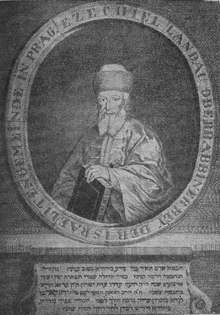
During World War II the community was herded into the new Opatów Ghetto set up by the Nazis along the Joselewicza, Zatylna, Wąska and Starowałowa Streets. The ghetto held about ten thousand Jews. It was destroyed during the Holocaust in Poland,[3] with about 8,000 Ghetto inmates deported to Treblinka extermination camp throughout October 1942 and additional 2,000 Jews sent to labour camps never to return.[4] Only about 300 of Opatów's pre-war Jewish population of around 5000 survived[5].
Opatów was a large center of the underground resistance in World War II. On the night of March 12/13 1943, a unit of Jędrusie, together with soldiers of the Home Army, attacked the local prison, releasing 82 inmates.
Economy
After the war, the city developed textiles and food manufacturing industries. The new housing estate and a Cultural Centre were built. Currently, the city sees its opportunities in the further development of tourism. However, there is no train station in Opatów – the nearest station is in Ostrowiec, 17 kilometres (11 mi) distance. Communication network consists of a city bus and private bus companies. The key focus areas of municipal government are the development of technical infrastructure, tourism, small business, attracting investors, and the promotion of education as well as the city itself. Traditional occupations and sources of income include agricultural farms, crafts, services and trade.[6]
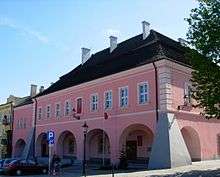
People
- Witold Gombrowicz, born in nearby village of Maloszyce.
- Włodzimierz Mazur, football player
- Tomasz Żelazowski, football player
- Avraham Yehoshua Heshel of Apt (Apter Rebbe, Apter Rov), lived here
- Itche Goldberg, Yiddish writer and scholar of Yiddish culture.
- Yisroel Hopsztajn (Hapstein)
- Mayer Kirshenblatt
- Yechezkel Landau
- Peter Litvin, musician, a descendant of Ruhlzalski Family of Opatow
Notes
- Virtual Shtetl (2014). "History of the Jewish community in Opatów". Museum of the History of Polish Jews. Part one of five. Archived from the original on 24 September 2015. Retrieved 16 July 2014.
- Hundert, Gershon David (1992). The Jews in a Private Polish Town: The Case of Opatow in the Eighteenth Century (Google Books). Baltimore and London: The Johns Hopkins University Press. Retrieved 18 July 2014.
- Virtual Shtetl (2014). "World War II ghetto in Opatów". Museum of the History of Polish Jews. Archived from the original on 3 July 2017. Retrieved 16 July 2014.
- Overview: "Getta Żydowskie" by Gedeon (in Polish) and "Ghetto List" by Michael Peters (in English).
- Megargee, Geoffrey (2012). Encyclopedia of Camps and Ghettos. Bloomington, Indiana: University of Indiana Press. ISBN 978-0-253-35599-7.
- City Hall (2013). "Opatów. Okres powojenny (Postwar period)". Urząd Miasta i Gminy w Opatowie. Archived from the original on 7 December 2013. Retrieved 19 July 2014.
External links
| Wikimedia Commons has media related to Opatów. |
- Official town website
- Saint Martin's Church in Opatów
- Jewish Quarterly Review, The Jews in a Polish Private Town by Gershon David Hundert. Center for Advanced Judaic Studies, University of Pennsylvania 1996.
- Gershon David Hundert, The Jews in a Polish Private Town: The Case of Opatów in the Eighteenth Century. Hardcover. The Johns Hopkins University Press, December 1, 1991 (Amazon); including Editorial Reviews. ISBN 0801842735.
- Opatów, Poland at JewishGen
